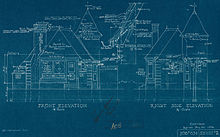Blueprint

| Part of series on |
| Technical drawings |
|---|
 |
A blueprint is a reproduction of a technical drawing or engineering drawing using a contact print process on light-sensitive sheets introduced by Sir John Herschel in 1842.[1] The process allowed rapid and accurate production of an unlimited number of copies. It was widely used for over a century for the reproduction of specification drawings used in construction and industry. Blueprints were characterized by white lines on a blue background, a negative of the original. Color or shades of grey could not be reproduced.
The process is obsolete, largely displaced by the diazo whiteprint process, and later by large-format xerographic photocopiers. It has almost entirely been superseded by digital computer-aided construction drawings.
The term blueprint continues to be used less formally to refer to any floor plan[2] (and even less formally, any type of plan).[3][4] Practising engineers, architects, and drafters often call them "drawings", "prints", or "plans".[5]
The blueprint process


The blueprint process is based on a photosensitive ferric compound. The best known is a process using ammonium ferric citrate and potassium ferricyanide.[6][7] The paper is impregnated with a solution of ammonium ferric citrate and dried. When the paper is illuminated, a photoreaction turns the trivalent ferric iron into divalent ferrous iron. The image is then developed using a solution of potassium ferricyanide forming insoluble ferroferricyanide (Prussian blue or Turnbull's blue) with the divalent iron. Excess ammonium ferric citrate and potassium ferricyanide are then washed away.[8] The process is also known as cyanotype.
This is a simple process for the reproduction of any light transmitting document.
This process has several features:[9]
- the image is stable
- as it is a contact process, no large-field optical system is required
- the reproduced document will have the same scale as the original
- the paper is soaked in liquid during processing, and minor distortions can occur
- the dark blue background makes it difficult to alter, thus preserving
- the approved drawing during use
- a record of the approved specifications
- the history of alterations recorded on the sheet
- the references to other drawings
Introduction of the blueprint process eliminated the expense of photolithographic reproduction or of hand-tracing of original drawings. By the later 1890s in American architectural offices, a blueprint was one-tenth the cost of a hand-traced reproduction.[10] The blueprint process is still used for special artistic and photographic effects, on paper and fabrics.[11][self-published source?]
Various base materials have been used for blueprints. Paper was a common choice; for more durable prints
Whiteprints

Traditional blueprints became obsolete when less expensive printing methods and digital displays became available.
In the early 1940s, cyanotype blueprint began to be supplanted by diazo prints, also known as whiteprints. This technique produces blue lines on a white background. The drawings are also called blue-lines or bluelines.[12][13] Other comparable dye-based prints were known as blacklines. Diazo prints remained in use until they were replaced by xerographic print processes.
Xerography is standard copy machine technology using
Digital
In most computer-aided design of parts to be machined, paper is avoided altogether, and the finished design is an image on the computer display. The computer-aided design program generates a
In the case of construction plans, such as road work or erecting a building, the supervising workers may view the "blueprints" directly on displays, rather than using printed paper sheets. These displays include mobile devices, such as smartphones or tablets.[14] Software allows users to view and annotate electronic drawing files. Construction crews use software in the field to edit, share, and view blueprint documents in real-time.[15]
Many of the original paper blueprints are archived since they are still in use. In many situations their conversion to digital form is prohibitively expensive. Most buildings and roads constructed before c. 1990 will only have paper blueprints, not digital. These originals have significant importance to the repair and alteration of constructions still in use, e.g. bridges, buildings, sewer systems, roads, railroads, etc., and sometimes in legal matters concerning the determination of, for example, property boundaries, or who owns (and/or is responsible for) a boundary wall.
See also
- Architectural reprography
- Cyanotype
- Floor plan
- Graph paper
- Heliographic copier
- Print reading
- Technical drawing
- Whiteprint
References
- ISBN 0-85229-135-3.
- ISBN 978-0-19-920687-2
- ^ "Blueprint". Dictionary.com. Retrieved February 6, 2016.
- ^ "Blueprint". Merriam-Webster Dictionary. Retrieved February 6, 2016.
- ISBN 978-1-63126-051-3.
- ^ Blue, WS: PSLC.
- ISBN 978-1-63126-051-3.
- ^ Bridgwater, William; Sherwood, Elizabeth J., eds. (1950). "blueprint". The Columbia Encyclopedia in One Volume (hardbound) (Second ed.). Morningside Heights, New York City: Columbia University Press. p. 214.
- ISBN 0471348767page 576
- ISBN 0520214943, pages 239–240
- ISBN 141169838X page 7[self-published source]
- ISBN 978-3527306732.
- ^ Blueprints replaced by whiteprints
- ^ Singer, Michael. "Crain Construction grows its 80-year-old business with iOS, Android tablets". tabtimes.com. Archived from the original on 22 May 2014. Retrieved 21 May 2014.
- ^ "Construction Blueprint App". HCSS. 15 December 2021. Retrieved 9 June 2022.
Further reading
 The dictionary definition of blueprint at Wiktionary
The dictionary definition of blueprint at Wiktionary Media related to Blueprints at Wikimedia Commons
Media related to Blueprints at Wikimedia Commons
- Page, Walter Hines; Page, Arthur Wilson (November 1915). "Man And His Machines: Electric Blue Printing Machine". The World's Work: A History of Our Time. XXXI: 113.
